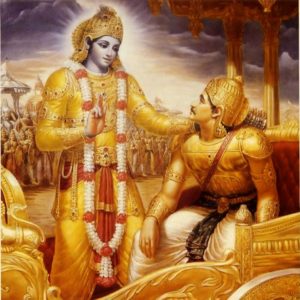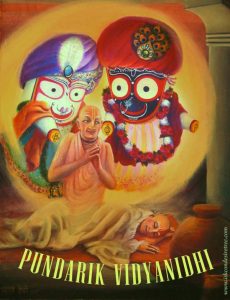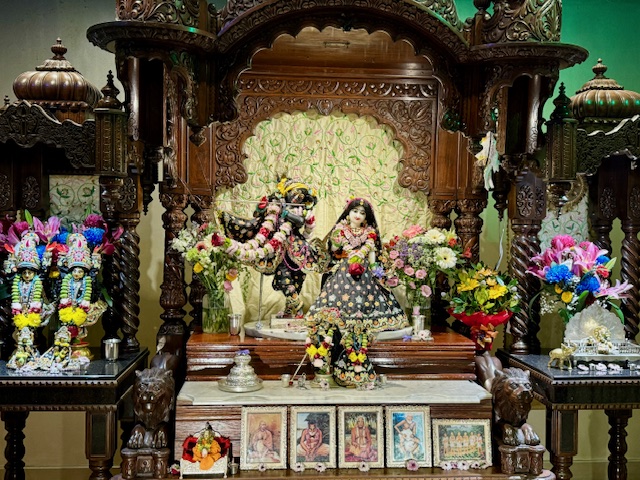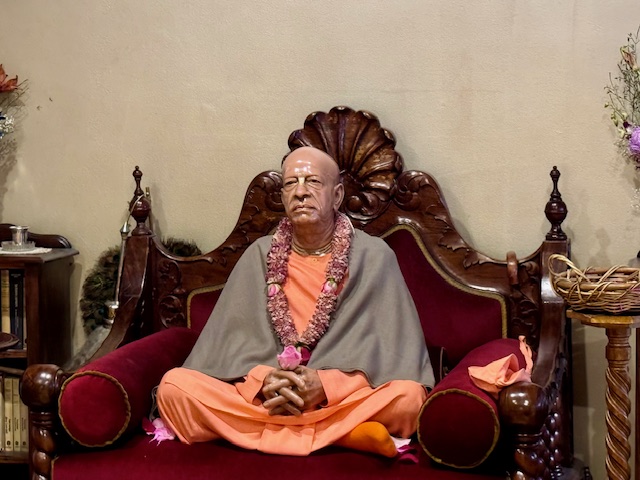 There is so much to be said about Srimati Yamuna-devi dasi.
There is so much to be said about Srimati Yamuna-devi dasi.
In October of 1970 I was one of a group of Srila Prabhupada’s disciples from America going to join him in India. On the way, we stopped in Brussels, and it was there, in an apartment, that I first met Yamuna-devi—and Malati and Syamasundara (I had met Gurudas before that, in Boston). Upon entering, I could immediately feel their intense, extraordinary devotion to Srila Prabhupada—it was so palpable, so tangible; the room was just suffused with their devotion—and we spent the next several hours there together. As enthusiastic as I was to go to India to be with Srila Prabhupada, I felt like I could stay in that room forever; I never wanted to leave the association of these amazing devotees who were so attached to Srila Prabhupada and so capable of serving him in such different ways.
Gurudas had arranged a cheap flight on a small airline, and so, that evening we boarded an old converted dual-propeller cargo plane, bound for Bombay with a stop in Cairo. In my mood of Krishna consciousness then, I was quite oblivious to things around me. I wanted to avoid maya—anything that could distract me from Krishna—and didn’t pay much heed to anything that didn’t relate directly to my service. I was focused on the idea of chanting and hearing every word of the Hare Krishna mantra distinctly, on always thinking about Krishna and never forgetting Him. And I had heard that Srila Prabhupada had said that if you have trouble hearing, you should chant loudly. And sometimes, to really get into the holy names—and to break out of any possible lethargy—I would jump up and down. One or two of the devotees told me that they were anxious about how people in Egypt might react to my chanting, but I was determined.
There was unrest in Egypt at that time, and when we landed in Cairo we were met on the tarmac by soldiers and armed security guards with bandoliers of bullets around their chests and machine guns over their shoulders. And as we deplaned, walking down the steps, the men were pointing machine guns in our direction. Then Yamuna, as I learned later, saw the guards suddenly move their guns up and down, shifting their aim. And when she turned around to see why, she saw me behind her, walking down the stairs chanting japa, jumping up and down.
Anyway, we escaped Egypt and flew to Bombay, where, as arranged by Srila Prabhupada, we were taken to Kailash Seksaria’s house. There I went through a period of confusion—some things were difficult for me to understand and cope with—and I wasn’t sure what to do. I was a relatively new devotee, at least compared with the others in the group, and somehow I just got the inspiration to go to Yamuna and Gurudas for help. What they told me was extraordinary, and for me, revolutionary. I entered their room feeling completely at a loss, but they turned the whole thing around, saying that Srila Prabhupada had sent me to engage them in thinking about him and about topics of deep significance. They turned the whole thing completely around, and I believe they were completely genuine in the way they took it and in what they said. And that was the beginning of what proved to be a very close relationship with them both.
While we were staying at Seksaria Bhavan, Srila Prabhupada introduced a new tune for the Gurvastakam prayers in the morning. He tried to teach some of the men, but they couldn’t quite get it. Then he decided to instruct Yamuna, in the presence of us all, and she picked it up right away. Afterward, Srila Prabhupada told Yamuna, “Learn to listen. You cannot follow nicely unless you hear nicely, and you cannot lead nicely unless you have learned to follow nicely.” And gradually the rest of us learned the new melody.
In Bombay, Srila Prabhupada was invited to attend the Vedanta Sammelan in Amritsar, and so a party of seven men and two women—Yamuna and Kausalya—traveled there with him by train. The Vedanta Ashram offered us two small rooms and the use of the large common courtyard just outside. Srila Prabhupada occupied one room, Yamuna and Kausalya the other.
Srila Prabhupada was very protective of the women, and he would have them ride to programs with him in his car while the men took rickshaws. He did programs in the morning and evening—and often in between. Kausalya told me that driving to one engagement, he mentioned that he needed new shoes. “Stop at the next Bata shoe store,” he said. In the store, he told Yamuna and Kausalya, “You choose the shoes for me,” and sat down. So, they looked all around the store and found some white crisscross plastic sandals that they thought would be just right. Each of them carried one shoe up to Srila Prabhupada, and they slipped them on his feet. He smiled and asked, “Do you like them?” They responded, “Yes.” “Then we will buy them.” And so he did.
In the afternoons when there was some free time, Yamuna would chant in the courtyard. It was very cold in Amritsar in November, but it would be a little warmer when the sun came out in the afternoon, and she would sit cross-legged with her back erect and chant Hare Krishna maha-mantra japa continuously with her eyes closed—nonstop. She told me then that when she chanted, her ears and mind and heart opened up to the holy names and the names would enter and she would just hear the sound. She would be fully absorbed in the sound, not even thinking that she was chanting the holy names or that these were names she was hearing—she was just absorbed in the sound.
After Amritsar, Srila Prabhupada and his party traveled by train back to Bombay. On the way, the train stopped at the New Delhi station, and a gentleman, a lawyer named D. D. Gupta who had been corresponding with Prabhupada and had been informed of his stopover, came to meet him. He requested Srila Prabhupada to leave some disciples in Delhi to start the activities there. Prabhupada turned to Gurudas, who was riding in the same compartment, and said, “This man is inviting us. Get down and see what you can do.” Gurudas asked for some devotees, and then he and Prabhupada agreed on a team: Yamuna, Gopala, Bhakta Bruce (now Bhanu Swami), and me.
Mr. Gupta arranged for us to stay in two rooms in Old Delhi, near Delhi Gate. The rooms were very basic—just plain concrete with whitewash on the walls—and they abutted the courtyard at the center of the building. We would have to walk around the courtyard to use the simple latrine (though, in urgent cases, we would often run!).
Mr. Gupta, it turned out, was a peculiar man. He was an advocate, but not a very big one. And he was miserly. He would keep his used, dead batteries in a drawer in the hope that they would come back to life.
The whole situation was very austere, but it was wonderful being with Gurudas and Yamuna. We were like a family, with Gurudas and Yamuna like our older brother and sister, taking care of us in the absence of our father, Srila Prabhupada.
After leaving us in Delhi and spending some days in Bombay, Srila Prabhupada proceeded to Indore for the Gita Jayanti Mahotsava, and our small party joined him there. Once, when we entered his room, he looked up from his desk, and Yamuna remarked, “Srila Prabhupada, you look just like a picture I have seen of your guru maharaja looking up from his desk.” And Srila Prabhupada replied, with all humility, “All that glitters is not gold. My guru maharaja was like gold; I am like iron.”
From Indore, Srila Prabhupada and his party traveled to Surat, in Gujarat, where we received an overwhelming reception. In Surat something happened—I actually haven’t thought of it for years. One day I was chanting my rounds on the roof of the house where we all were staying, and somehow my mind got fixed on the idea that . . . I had heard that Srila Prabhupada said that if you can deliver just one soul back home, back to Godhead, then your own deliverance is assured. Somehow I thought of my girlfriend from before I joined, and I considered, “Maybe I should have her come and join me, and I will make her a pure devotee, and then I’ll go back to Godhead.” It all made perfect sense to me, but I thought I had better consult Gurudas and Yamuna. I was very serious, and they questioned me, “Why her in particular? There are so many souls that you could deliver back to Godhead—why her?” Indirectly, they pointed out my attachment for her, and they induced me to abandon that strategy.
After Surat, Srila Prabhupada stopped in Bombay, where he met with the few devotees based there. We were all staying at the Sea Palace Hotel, which was pure vegetarian and belonged to Sri Ramchand Chhabria, who knew the devotees from England and was himself vegetarian. While we were there, a new issue of Back to Godhead magazine arrived, and the first article was Srila Prabhupada’s poem “Markine Bhagavata-dharma,” written when he initially arrived in America, in Boston. We had never seen the poem before; it had never been published. Gurudas, Yamuna, and I got together to look at the magazine, and Yamuna read the poem out loud. It was written in a mood of deep humility and dependence on Krishna. And when she got to the end—“Signed—the most unfortunate, insignificant beggar, A. C. Bhaktivedanta Swami”—she burst into tears. She couldn’t contain herself.
Years later, in September 2002, after celebrating the anniversary of Srila Prabhupada’s arrival in America, I wrote Yamuna-devi, “Two days ago I spoke of the time Srila Prabhupada’s poem “Markine Bhagavata-dharma” first appeared in English in BTG and you read it to Gurudas Prabhu and me and at the end you cried.” And she replied, “I sang this prayer this year on Vyasa-puja day, and all the while torrents of tears fell. One of my weaknesses is tears.”
From Bombay Srila Prabhupada went to Allahabad for the Ardha-kumbha-mela, and Yamuna and I were there with him. Srila Prabhupada spoke on the story of Ajamila and the holy name from the Sixth Canto of Srimad-Bhagavatam. Only the first two cantos had been translated and published, so Prabhupada read from his Sanskrit Bhagavatam with commentaries, sometimes translating from Sridhara Swami’s and occasionally from Jiva Gosvami’s.
While there, I heard that Srila Prabhupada had said that he was speaking for Yamuna. And in April 2007, when Yamuna visited me in Carpinteria and I asked her about it, she told me something that etched an indelible impression on my heart. She always thought that she had as much right as anyone else to walk or sit close to Srila Prabhupada, she explained. And generally when he spoke, she would sit in front of the vyasasana at his feet. She had never really distinguished in terms of etiquette that men should walk closer to Prabhupada, and women farther, or that men should sit closer to him, and women farther. And the movement had been like that—like a family. In Allahabad, however, one of the sannyasis had explained to her that in India the women sat apart and that she should too.
About 10:30 the next morning, after she hadn’t sat at the foot of Srila Prabhupada’s vyasasana as usual, Prabhupada noticed her passing by his tent and called out, “Yamuna, come in here.” She entered and offered her obeisances, and before she got up, he said, “So, you don’t want to hear anymore?” Yamuna burst into tears; Prabhupada—hearing from him—was her life. “Where were you this morning?” he asked. Yamuna told him what had happened. Prabhupada was silent.
That, Yamuna told me, was a turning point in her life. It changed her whole orientation in Krishna consciousness. She suddenly had the realization that she would not always have Prabhupada’s company. Since 1967, when Srila Prabhupada recovered from his stroke, she had never been able to conceive of ever being separated from him. The devotees were so dependent on him for everything, it was inconceivable to them that he would not be with them. But, she told me, every disciple must come to a personal realization that there will be a time when the spiritual master will not be present. And for her, that moment came in Allahabad, after her talks with the sannyasi and then with Srila Prabhupada.
Sitting in Prabhupada’s tent, she asked him, “How much time did you actually spend with your guru maharaja?” “Very few occasions,” he said. “Maybe five or six. But they were very intimate. We used to walk and talk so many things.” Then he said, “Those who think that association with the spiritual master is physical, they are no better than a mosquito sitting on the lap of a king. And what is the business of a mosquito? Simply to suck blood. So many of my godbrothers, they were big, big sannyasis, and they thought like that, and they simply sucked blood.”
Yamuna took Prabhupada’s words as confirmation. She now understood that she needed to go to another place to explore her relationship with him and her service to him in separation. She began to consider the question of vani (words, instructions) and vapuh (body, form), and she got more and more insight into it. As she told me, it is something “unlimitedly deep and profound. You can hear the terms on the surface, but vani means to again be in Prabhupada’s presence”—to be in his presence in separation as much as when you were in his physical association. “So, that was a turning point for me, to realize that Prabhupada was going to leave this planet: ‘He is an old man, and he is going to leave, and I have to prepare.’ ” She took it that from that moment she must start mentally preparing—find a way of continuing in Krishna consciousness that was not based on Srila Prabhupada’s personal association.
“So, that is that story of hearing,” she continued. “Prabhupada said, ‘I am speaking because you want to hear so much. I am speaking as much because you want to hear so much.’ So he knew that hunger. I never expressed that to him, but he knew.”As Yamuna often said, Srila Prabhupada was completely aware of every disciple in every way—both their internal consciousness and the external manifestations of their service.
Vani and vapuh became a major theme in Yamuna’s life—how to maintain one’s connection with Srila Prabhupada through vani to the same degree and with the same intensity as in his physical, even close personal, presence. She was convinced that it was possible, and she arranged her life in such a way as to always receive his guidance and mercy—to always be in his association.
Then came the Bombay pandal. Syamasundara Prabhu, who was the temple president, divided the work into different departments, with one devotee in charge of each. (Often, that devotee was the department.) And Yamuna was in charge of the Deities. We had very little money. Although we were raising funds for the pandal program, we needed it all for the event. And the treasurer, Rishi Kumar, was very tight with the money, which Srila Prabhupada considered a good quality for the treasurer. Sometimes Rishi Kumar would put a sign on his office door: “Closed for three days.” So, Yamuna was charged with raising the funds for the Deities. That was the year we got big marble ones. In the pandal we had small brass Deities, and on the last day of the program there was to be a procession from the pandal, at Cross Maidan, to Chowpatty, where there would be a program at the beach, at which Sri Sri Radha-Rasabihari would be revealed for the first time to the people of Bombay. And she just couldn’t raise the money.
One day while she was out endeavoring to raise funds for the Deities, Yamuna became so disappointed and distraught that she just sat down on the sidewalk and wept. A black limousine, with a pious, distinguished-looking gentleman in the back seat, stopped on the road before her, and the gentleman got out of the car and asked her what was the matter. “We’re having a pandal program,” she explained, “and I’m in charge of the Deities’ outfits and decorations, and I have to raise the money, but no one is giving, and we’re running out of time.” “Don’t worry,” he replied. “I am the chairman of two of the biggest temple trusts in Bombay. How much do you need?” “Two thousand five hundred rupees,” which was really a lot back then. “Don’t worry,” he said. “Just come with me to my office, and I’ll give you a check for the whole amount.” She was that sincere and dedicated.
From Bombay, Srila Prabhupada sent Tamal Krishna and me to Calcutta to arrange a similar pandal program, and eventually Yamuna also came, and soon she was engaged in the service of the Deities there, Sri Sri Radha-Govinda. Every morning we would look forward to the darshan of the Deities. The worship was so beautiful—so devotional.
One day at the pandal site I approached Yamuna and told her that I had some questions regarding my future and the future of the movement that I just could not answer but with which I didn’t want to approach Srila Prabhupada directly. The whole mood at the time was, “Don’t disturb Srila Prabhupada. He has to translate. He has important things to do. Don’t go to Srila Prabhupada.” When I told Yamuna my questions, however, she responded, “No, you should go to him. You are just the type of devotee he would want to spend time with, and these are just the types of questions he would want to answer.”
So, based on Yamuna’s advice, I approached Srila Prabhupada in his room at the temple, and my meeting with him was very significant. “Before joining the movement,” I said, “I was interested in making movies, and I even made one. So I was thinking maybe I should make movies about Krishna consciousness.” Srila Prabhupada replied, “That, others are doing. Our main medium is books.”
Then I said, “Srila Prabhupada, now you are here, so everything is all right. But what if in the course of time, when you are not here, ISKCON falls from the standard? What should I do?” And Srila Prabhupada replied, “You are also one of the important members of the Society”—I was actually very new—“You are also one of the important members of the Society, so you work for the correction. But don’t leave.”
These instructions have been guiding me ever since. And it was Yamuna who advised me to go and ask Prabhupada directly.
After Calcutta was the Delhi pandal. Again Yamuna arranged beautiful Deity worship—for Sri Sri Radha-Gokulananda, who later went to Bhaktivedanta Manor in England. The darshans were spectacular. But after the program, she was very sick. She was staying in the same, large house as Srila Prabhupada, and he noticed that she was missing. He inquired and found out that she was sick. She was resting in a small room—like a closet. Because she was sick, she had to have her own room, and that was all the devotees could offer. Srila Prabhupada went to visit her and found that no one was really taking care of her, and he became concerned and assigned a devotee to care for her. It was cold, and I think he gave her his own room heater—perhaps the only one. And he said that we have to take care of our devotees when they fall ill.
After the Delhi pandal, I went to Madras, while the rest of the party went to Vrindavan with Srila Prabhupada for the first time. There was one car—an Ambassador—with Srila Prabhupada and some men, and a bus with the rest of the devotees. Prabhupada was in the car, and he noticed Yamuna climbing into the bus. He said, “Wait! Wait!” He called her, knowing that she was very sick, and told the men to get out. Then he had her get in the back seat with Gurudas and one other man—Prabhupada was in front with the driver—and the other men went on the bus.
In time, Srila Prabhupada got some land in Vrindavan and put Gurudas and Yamuna in charge. And she related a couple of incidents to me that I consider to be very instructive. Once, a small group of devotees went to the Radha-Damodara temple, and the Goswami in charge invited them to have prasada. The devotees sat in the courtyard, and the Goswami arranged the Deities’ maha-prasada for them. While they were honoring the prasada, he began to blaspheme Srila Prabhupada—“Why does he wear a ring?” and all sorts of things. The devotees felt extremely uncomfortable and were tempted to just get up and walk out, but somehow they decided not to. After the incident, Gurudas and Yamuna reported to Srila Prabhupada what had happened, and Prabhupada instructed, “In Vrindavan there are five thousand caste goswamis, five thousand shopkeepers, and five thousand widows, and we have to keep good relations with all of them; otherwise we will end up in court like the Gaudiya Matha.”
On another occasion, Srila Prabhupada sent Gurudas and Yamuna to meet his godbrother Professor O. B. L. Kapoor. At some stage after Srila Bhaktisiddhanta Sarasvati Thakura left, Professor Kapoor had taken shelter of a babaji as a siksa-guru. Srila Bhaktisiddhanta had vehemently criticized these babajis, and they had staunchly opposed him. So this was a very peculiar situation, that Professor Kapoor had taken shelter of a babaji who was the type of person who was the object of his spiritual master’s criticism and in turn opposed his spiritual master. But Srila Prabhupada simply said, “That is his weakness”—that’s all. He didn’t consider that this disqualified Dr. Kapoor from helping the movement. Srila Prabhupada had a very broad view of the Krishna consciousness movement and of engaging people in it, and that was demonstrated quite vividly in Vrindavan.
Then Srila Prabhupada left us, and things did change. And I didn’t see Gurudas and Yamuna for many years. But then somehow my relationship with Yamuna was revived. She had been a mentor to me, and decades later she was again. Although so many years had passed, when we met again it was more or less the same—the relationship hadn’t changed, and we shared thoughts about Srila Prabhupada and his service and his mission. She was always very concerned about the mission, that Srila Prabhupada’s legacy should be preserved as it is and not adulterated or compromised.
I also saw that she was very absorbed in Krishna consciousness. When I think of the five main processes of devotional service (pancanga-bhakti), she was very strong in all of them.
sadhu-sanga, nama-kirtana, bhagavata-sravana
mathura-vasa, sri-murtira sraddhaya sevana
“One should associate with devotees, chant the holy name of the Lord, hear Srimad-Bhagavatam, reside at Mathura, and worship the Deity with faith and veneration.”
She was very strong in reading and studying. Every morning she would read the Bhagavatam and the teachings of the more recent acharyas—Srila Bhaktisiddhanta Sarasvati Thakura and Srila Bhaktivinoda Thakura—taking special note when they spoke about the holy name. This was a major focus for her, and she would relish reading, especially instructions related to nama-bhajana and to guru-seva.
Another thing about Yamuna-devi struck me as amazing. About the time of the first Bombay pandal, when we were staying in Akash Ganga, a high-rise apartment building in an affluent part of central Bombay, when we would go out she would stay back and clean. She would clean the whole place, for hours. And while cleaning, she would sing in a very ecstatic mood. The rest of us were going here and there—for service, but there were incidental benefits: seeing exotic India, meeting all sorts of cultured and interesting people, tasting varieties of delicious prasada—and she was staying back and cleaning. She put her heart into it and would be singing in an ecstatic mood.
Later, in April 2007, when she visited me in Carpinteria, I asked her about this, and she said that Srila Prabhupada had put greater emphasis on bhagavata-marga because he wanted his books produced, so they would be there for all time, and because he wanted his books distributed, so that the income from the sales would support the expansion of the mission. So he didn’t have much time to personally train disciples in pancaratrika-vidhi. But he did train her, and she considered personal service to him to be in the same category as personal service to the Deity. And, of course, she is right. Once, a devotee came forward to fan Srila Prabhupada, and Prabhupada stopped him, saying that he wasn’t a brahman. So, cleanliness is one of the basic principles of Deity worship. But Yamuna didn’t distinguish between cleaning the guru’s ashram and cleaning the Deity room. As she told me, “In Bombay, I learned to take joy in that cleaning. Whether you are serving the spiritual master or the arca-vigraha, the cleaning is external and internal. It is a very spiritual engagement—as powerful as distributing books.”
She explained that Srila Prabhupada would teach each servant about the importance and standards of cleanliness according to the servant’s capacity to understand. And she told me how strictly he had trained her. He had his four-tiered cooker, and if he found a black spot on the bottom of any of the pots, he would really chastise the servant: “This is not Vaishnava. This is Muslim. No Vaishnava will ever leave a black spot on any of the pots in the kitchen.” Prabhupada’s cooker was always to shine like gold.
Based on Srila Prabhupada’s instructions, Yamuna developed a whole system for cleaning his quarters in Vrindavan—an elaborate five-step procedure, going from bottom to top and top to bottom. First, she would get the big dirt off the bottom, then she would go up as far as she could reach, dusting, and then she would go back to the bottom, cleaning everything as perfectly as she could. If there was anything wrong, Prabhupada would notice and tell her about it. And keeping the rooms clean in Vrindavan was very hard: with the simmering sands of Raman Reti and the whole place being a construction zone, there was always dirt and corrosion—everywhere. The walls of Prabhupada’s rooms were pale yellow, and the floors were black stone. The floors were covered with rugs, and the rugs were covered with white sheets.
One morning when Srila Prabhupada came back from his walk, after Yamuna had gone through her five-step procedure and everything looked as clean as could be, he told her, “Please clean my room, Yamuna. Haven’t I taught you to clean?” “No, Srila Prabhupada,” she said. “How may I improve my cleaning?” He didn’t say anything. On his desk were a picture of Srila Bhaktisiddhanta Sarasvati, his eyeglass case, his tilak, pens, a flower vase, and a staple gun. Srila Prabhupada took the staple gun, which was about two and a half inches long, removed it from its plastic case, lifted up the metal staple holder, and ran his little finger, his pinkie, across the thin metal strip between the staple holder and the hinge. . . . Dust. Dust. “When will you learn how to clean?”
If Srila Prabhupada had had the time, Yamuna told me, he would have trained all his disciples in both pancaratrika-vidhi and bhagavata-vidhi, but because he was focused more on bhagavata-vidhi, he mainly trained only his close managers and personal servants, be they men or women, in both. Srila Prabhupada knew the consciousness of his disciples—he knew their capacity—and he would train them according to their capacity to absorb it.
Cooking, like cleanliness, is also part of Deity worship, and Yamuna was, of course, most expert. Once, when Srila Prabhupada was coming to Vrindavan, she went to the Vraja-vasis and asked, “What is the best way to make Vraja-vasi rotis?” They told her, “You have to get this red Punjabi wheat berry. You have to grind it in the morning, and then you have to cook it with neem wood.”
When Prabhupada came she didn’t say a word to him, but she got that red wheat berry from Punjab, she had it ground in the morning, and she cooked the chapatis with neem wood. Then she brought the plate in to Prabhupada and put the hot chapati on his plate. He took one bite and said, “This is the red Punjabi wheat berry. You ground it this morning and cooked it with neem wood.” She hadn’t said a word to him—he just knew.
That was at the Radha-Damodara temple in 1972. And there is a sequel to the story about the Vraja-vasi chapatis, from Raman Reti in 1973. I am not a cook—chapatis are too technical for me—so I will read the transcription of Yamuna’s account to me in Carpinteria:
“One time when Srila Prabhupada came—I think it was the first time I met Satsvarupa dasa Gosvami; he was Prabhupada’s servant—I was on a bucket stove again, on the floor—no kitchen. I was making Prabhupada’s prasada, and as you may or may not know, when you cook with a bucket stove and you have a little bit of hard coal and then a little bit of soft coal and then a little bit of cow dung, it is a little hard to regulate. There is a certain temperature, and you cannot turn a switch to make it higher or lower. And then, depending on the thickness of the pot, you know what intensity you want. And then there is what you call a thawa, which is an iron griddle, concave, and to make a chapati you keep that on the stove and then you lift it off and you put the chapati on top of the flame. So, I made chapatis for Prabhupada’s lunch.
“Satsvarupa Maharaja wanted to bring in the lunch, thinking that I probably shouldn’t do it. He brought in the plate, came back into the kitchen, and said, ‘Prabhupada wants me to teach you how to make chapatis.’ And I said, ‘Oh, Maharaja, I would be so grateful if you could do that. I’d love to learn to make chapatis. Please.’
“Then I got up, and he began to wash his hands. By the time he sat down and rolled out a chapati, the thawa was really hot. He rolled out an octopus-like chapati. Now, when you roll out a chapati, the ball bearings for rolling it out is the dusting of flour, and if you roll the chapati in too much flour you actually roll flour into the surface of the flatbread and then even if you try to flap it off, you still have a crust of flour. So, you use a minimal amount for the ball bearings and then flap off the little extra.
“His octopus was covered with flour on a hot thawa. When he put it on, I said, ‘Maharaja, what should I be looking for?’ He said, ‘You wait until there are pimples on the top.’ As soon as the chapati hit the griddle, very hot, the pimples came very fast. He turned the chapati over, and there were little burnt holes. So there was no question of it puffing up.
“So, he put it on, and the little bubbles appeared at different places, and he took it in to Prabhupada. Then he came back and told me, ‘Prabhupada said, “This is excellent.” ’
Yamuna concludes, “So that’s how Prabhupada taught me. It was never with a whip, but they were beatings nonetheless. They were beatings over my head.”
Another time, in 1974, one of the devotees based in Vrindavan approached Yamuna and said, “My wife is coming, and she is a very good cook. She wants to cook for Prabhupada.” Yamuna replied, “How wonderful. I will be glad to engage her in Prabhupada’s service.” The new cook arrived after the big Mayapur festival, when almost all the devotees became very ill with dysentery and other maladies. There was really no proper arrangement for them, but Gurudas and Yamuna cared for them like parents. Yamuna was doing the cooking for the devotees there at Fogel Ashram. Under the circumstances, she really didn’t have time to cook for Srila Prabhupada, so she was very happy that the new cook was there. Meanwhile, Yamuna was trying to make arrangements for the devotees’ prasada. She had no facility, she was unable to speak Hindi and communicate with the locals, and the assistant cooks were ready to walk out at any time. She was working practically twenty-four hours. And she didn’t go to see Prabhupada the entire time.
She began to get messages: “Prabhupada wants you”—but she didn’t go. She just replied, “Tell him I am really busy.” She told me later, “Bad, very bad—really low consciousness.”
When finally she came to Prabhupada’s room, he was about to go out. So she came back the next morning.
Yamuna had given the new cook specific instructions. Still, the lady had taken Srila Prabhupada’s cooker and his unclean laundry and stuffed them in a bolster pillowcase meant for his seating area, now black all over the bottom. Yamuna arrived just as the lady was putting the cooker in with the clothes, in the pillowcase. Srila Prabhupada was also standing there, watching the cooker being shoved into the pillowcase. He didn’t say a word—not to the cook, not to Yamuna.
“Prabhupada knows everything,” Yamuna told me later. Thus he said to her, “Are you too busy to come? So I am delaying my departure for one day.” The men said, “But the cars are ready. We’re just loading them.” “No, Yamuna will stay here and cook for me tomorrow,” Srila Prabhupada stated unequivocally. “I am staying, and she is going to cook for me tomorrow morning, and then we will go.”
Cleanliness. More than thirty years later, Yamuna told me, “I can honestly say that I joyously engage in cleaning, and so in our ashram [in Saranagati, Canada] we sing and clean, sometimes for hours and hours and hours. Our place is very primitive; we have a dirt floor and walls, and a lot of earth outside. It is very simple, but we like to clean a lot. We enjoy cleaning, for Srila Prabhupada and the Deities.”
Kirtan. Yamuna had a dream. I don’t remember the details, and it is a little delicate, because she was a very private person. Anyway, in this dream, or vision—whatever it was, she took it as very real—she was a sage in the forest and Srila Prabhupada was also in the same forest, and somehow he engaged her in doing kirtan. She felt that from her past life there was a connection with Srila Prabhupada in relation to kirtan.
About Srila Prabhupada’s kirtan she said, “Srila Prabhupada’s kirtan had no tinge of being a performance. It was purely for the pleasure of Krishna. It allowed the chanters access to the fact that the Lord’s holy name and the Lord are nondifferent. He said that the key to engaging in kirtan without anartha was hearing and studying our literature, and that gradually it would rise to the platform of pure devotional service.”
And in an e-mail to Bhakta Carl, now Kalachandji das, she wrote, “Leading and chanting in kirtan has little to do with how we sound to each other. It has much more to do with how we call out to Krishna and immerse ourselves in hearing the vibrations of the holy names. What a vehicle for experiencing love of Godhead.”
When Yamuna and the other devotees were recording with the Beatles, George Harrison was so impressed by her singing that he told her he could make her one of the most famous and celebrated vocalists in the world. But she wasn’t interested. Her singing was meant for another purpose—pure devotional service to please Srila Prabhupada and Sri Sri Radha-Govinda.
Yamuna said that to the degree one follows Srila Prabhupada, to that degree things are revealed. And she gave the example of Bhakti Tirtha Swami. She felt that because of his deep connection with the holy name—his dedication to japa, his private time with japa—he was able to perceive Srila Prabhupada’s presence in separation. She said, “Prabhupada freely gave everything to all of us. But it is the individual’s hankering, which leads him to make certain decisions in his life to catch that mercy, that facilitates his or her perception of Srila Prabhupada, especially in separation.”
Yamuna recalled an incident that demonstrated to her unequivocally how Prabhupada knew his disciples. She came to the courtyard of the Radha-Damodara temple in the wee hours of one morning, remaining as silent as humanly possible so as not to disturb Srila Prabhupada, and he came out of his room and called her name. “There was no way Prabhupada could have known that I was there at one thirty in the morning,” she said. “I didn’t make any noise.”
But then she balanced her statement: “On the other hand, there were many times when he would say, ‘I want your report. Otherwise how do I know?’ ” And she added, “There were times when I did it, but other times, because of low Krishna consciousness, I ceased reporting in an honest way, and it contributed to my fall, to my weaknesses in Krishna consciousness. When I was open and revealed everything honestly in my reporting to Prabhupada, as we are supposed to report to Krishna, I was stronger in Krishna consciousness. And when I closed that avenue off, my consciousness suffered.”
In her profound humility, she explained, “Srila Prabhupada’s presence in vani and vapuh, or our ability to perceive his presence in his vani and vapuh, depends on our consciousness—whether we are able to perceive a drop of who Prabhupada was. Some devotees who never had Srila Prabhupada’s company, with their laulyam and their greed for it had more of it than I sometimes did while I was in his company, depending on my consciousness. . . .
“I still have no idea of the greatness of Prabhupada’s presence, then or now, although I think about it a lot, meditate on it a lot. We discuss it almost every day. It comes up in some form or other in our morning Bhagavatam class. . . . Prabhupada’s presence then and now—vani and vapuh. And it is very important to hold onto his presence as the focal point in our maturation in spiritual life, because he is the center in our spiritual life. Nothing comes without his presence. Even if the mercy comes to us through other forms, from endless different places—still, he is the fountainhead. . . . If I am qualified, then certain mercies will come to me. Mercy is not something you bargain for or arrange for or even desire for very deeply. You can have intense hankering, and then whatever comes—whatever form the mercy comes in—it is so Krishna conscious.”
Inevitably, we come toward the end of Yamuna-devi’s stay with us. After Srila Prabhupada’s disappearance day in 2009, she wrote me a letter that shows her deep absorption in Srila Prabhupada and in the holy names, and her intimate relationship with Srila Prabhupada. I think that she really did understand Prabhupada and his mission. He gave her a lot of instruction.
“Dear Giriraj Swami, Pranama dandavats. Jaya Srila Prabhupada! I wanted to share a few thoughts and reflections on yesterday, Srila Prabhupada’s thirty-second disappearance day. We observed the day first at Radha-Banabehari Mandir with our morning program at Radha-Banabehari Mandir, then at a midday program at Govardhana Academy [the school at Saranagati], introducing the students to the traditional way Srila Prabhupada instructed us to honor this day, and then in the evening at a program with adults in the community, who for convenience regularly meet in the evening for any kind of Vaishnava holy day.
“Last night Yadubara showed his preliminary edited footage for DVD Eleven: ‘Srila Prabhupada’s Final Pastimes.’ Though I had seen much of the footage before, it had been without comment, and not arranged in sequence to tell a visual story of Srila Prabhupada’s final days and hours, the moment of his passing, and the aftermath—the Vrindavan parikrama and the samadhi entombment.
“One evening, sitting with my back to Srila Prabhupada’s front bucket seat, riding in a van from Tittenhurst [John Lennon’s estate] to a Conway Hall lecture in London, Srila Prabhupada said loud enough for me to hear, ‘When I die, see that my body is taken on a palanquin around Vrindavan on parikrama.’ Stunned, but immediately attentive to these words, I turned around, and on my knees, bent forward from the waist so that my head was even with his shoulder, I said, ‘Why have you told me to do this, Srila Prabhupada? Better that you tell Tamal Krishna. He has more access to seeing that this is done than I do.’ He replied, ‘No, you can tell him.’ He fell silent and said no more. I too fell silent and said no more.
“Yadubara’s footage last night of the thickest pastime of Srila Prabhupada’s life with us—his passing—was poignant and moving. Though I was not there physically with Srila Prabhupada, I could not have felt closer to him or experienced more of his presence had I been so. Every moment of every day has been a meditation on Srila Prabhupada, and we have been engaged in constant kirtan. Perhaps it would have been difficult for me even to have been there at that time, for except Pisima, it is clear that women were not allowed close proximity to Srila Prabhupada, and that might have been almost unbearable for me after the closeness I experienced in previous years with him.”
She wrote more, expressing appreciation for the devotional mood and service of some of Prabhupada’s disciples who were there—they had “a shared intent to follow Srila Prabhupada’s instructions, glorify his mood, honor his example, and share that with others.” But her letter also expressed her concern about how at a certain point the role of women in the movement had changed. In earlier days . . . of course, she was exceptional—she would lead kirtan before thousands of people, speak before thousands of people, and render personal service to Srila Prabhupada. As she told me, at Tittenhurst she was basically Srila Prabhupada’s personal servant—she and Malati and Janaki. Purusottama would do some of the correspondence, and some of the men would give massage, but basically these ladies were doing the personal service.
She said that one day Prabhupada came into his room—they had just made his bed and done whatever else had to be done in the room—and said, “This is very unusual,” meaning for a sannyasi to have women do that service. He said, “This is very unusual, but it is appropriate.” He continued, “Sometimes I am like your father and you are like my daughters, and sometimes you are like my mothers and I am like your son.”
In the last year there was tremendous concern about Yamuna-devi’s health. At different stages she spoke to me about her condition and options, but then toward the end, perhaps in September, she came to a point with regards to her heart. Because of her size and age, the doctors were afraid to perform an invasive procedure, yet if they didn’t, there was every chance she would have heart failure, at any time. For a while she wasn’t sure what to do, but in the end she decided to just return to her home and depend on Krishna.
She said a few times that she was ready to go, that she felt she had done what she was meant to do, or what she could do, in this life, and she was ready to go. She had no fear, and no regrets. Personally, I questioned her conclusion about her service, and I suggested, “Well, you may have something left to do in terms of service to Srila Prabhupada.” I was thinking of her writing, that she should write about her experiences with and realizations about Srila Prabhupada. But she said, “No, I have thought about it, and there’s nothing really that I have to stay to do. If there is anything—if I am given more time—it is to try to help the women in the movement.” And she added, “I don’t think that you, as a sannyasi, can understand what the women in the movement experience. But if Krishna does give me some more time, I would like to do something for the women, to support the women, to give a strong voice to the women.”
No matter how dire her physical condition was, she was so Krishna conscious. My conversations with her were quite frequent after she went to Bhaktivedanta Hospital. Naturally, I was concerned about her medical condition, and so we would talk about it, and somehow or other, without my knowing how she got there, she would be talking about Krishna and Srila Prabhupada and the holy name and how wonderful devotees were and how merciful Prabhupada and Krishna were and how grateful she was. Quite the opposite of what I often experience with myself: I begin talking about Krishna and then—I don’t know how it happens—somehow I’m talking about my body. With her, I would bring up her body—how she was doing and if I could help in any way—and without my knowing how, suddenly we were talking about Krishna and Prabhupada and the holy name and the prayers of the acharyas and the wonderful service of the other devotees and just how grateful she was for what she had been given.
At about 6:30 in the morning on December 20, Yamuna’s constant companion and spiritual confidante, Dinatarini dasi, found that Yamuna had left. Her hand was in her bead bag, and a slight smile was on her face. She looked completely at peace—even blissful. She had been unafraid of death. She had been confident that she would again be with Srila Prabhupada, or somehow engaged in serving his mission. Such is the destination that awaits anyone who gives his or her life fully to serving Srila Prabhupada, his vani, his vapuh.
Yamuna-devi was a beautiful soul, a divine servant of Srila Prabhupada, his mission, and his Lords. She exemplified nama-ruci (taste for the holy name), jiva-daya (mercy for the living entities), and vaisnava-seva (service to the devotees). She was a mentor, guide, and friend to many, including me, and we will miss her personal presence. Still, we shall try to serve her in separation by upholding the ideals she held dear.
In conclusion, I quote from a letter Yamuna wrote me some years ago, which has given me some solace and guidance at this time:
“I remember when Dina and I visited you in your house in Vrindavan. We asked you one question, and you took three hours to answer it: ‘How has your relationship with Srila Prabhupada changed since his departure?’ ” Again, vani and vapuh. She continued, “The departure of loved ones helps us to change, to go deeper. Surely this will happen.”








 “Now these Christmas holidays have begun in your country. Throughout the whole month of December you’ll observe nice festivities. Why? It began with God consciousness. Jesus Christ came to give you God consciousness, and in relation to him these festivities are going on. It may have degraded into another form, but the beginning was God consciousness. Now we may have lost it. But people cannot be happy without reviving God consciousness. It may be named differently—‘Krishna consciousness’—but that means God consciousness. That is the necessity. We want to love somebody. Our love will be perfected when we love Krishna, or God. We are teaching that. Try to love God, and if you love God, if you love Krishna, then automatically you love everybody. That is the perfection of love.”
“Now these Christmas holidays have begun in your country. Throughout the whole month of December you’ll observe nice festivities. Why? It began with God consciousness. Jesus Christ came to give you God consciousness, and in relation to him these festivities are going on. It may have degraded into another form, but the beginning was God consciousness. Now we may have lost it. But people cannot be happy without reviving God consciousness. It may be named differently—‘Krishna consciousness’—but that means God consciousness. That is the necessity. We want to love somebody. Our love will be perfected when we love Krishna, or God. We are teaching that. Try to love God, and if you love God, if you love Krishna, then automatically you love everybody. That is the perfection of love.”

















